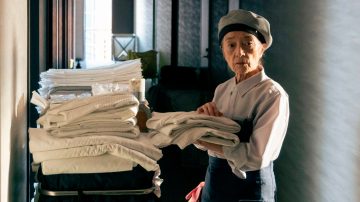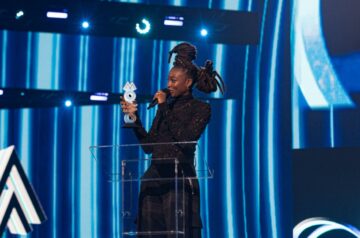

Kaitlin, talk us through your current series…
For the past couple of years I have been making work about my grandmother, mother, and myself. When I first began this project, I wanted to explore the pasts of my grandmother and mother, in order to better understand who they are as women. Growing up, I always knew there were pockets of mystery to their pasts, but I never truly understood what those were, or how it’s made them the women they are today.
As my exploration continued, I realised that this body of work was going to be about something much more than exploring their histories. A catalyst began to occur, and I discovered that while trying to navigate through their lives, I was confused by my own. This series has, and continues to bring up the complexities that exist within matriarchal relationships, identity, femininity, sexuality, womanhood, and isolation.
ArrayWhat drew you to photograph the women in your immediate family?
I feel that so many things compelled me to start this work, but it was all set into motion organically. My father passed away when I was a young girl and since then, I have had a much heavier female presence in my life than male. I have always felt more comfortable around women, especially my mother and grandmother. As I got older and began to see my mother as a daughter and my grandmother as a mother, I uncovered vulnerabilities in the two of them that I had not seen before.


The more we would photograph together, the more I would uncover things in them that were so new, but felt so familiar. Photography is the only way I know how to try and understand my life and having felt very lost and confused throughout much of it, it became apparent to me that this was what I had to do to make sense of everything.
Can you tell us a bit about where you live and what the lifestyle is like there?
I was born and raised in South Florida and this is where a large majority of my work is made. The harsh sunlight and stimulating colour palette that exists within the landscape is like no other. I have a strong affinity for natural light, so making work in Florida is really special to me. It will always be home and a big part of who I am, so it also feels right for it to be the backdrop for my work.
ArrayWhat have been your mother and grandmother’s reactions to the photos? Do they enjoy taking part?
When I’m making photos with my mother and grandmother, I like to be as transparent as possible. I want them to be aware of what I’m thinking and exploring every step of the way because the fear of exploiting them is always in the back of my mind. Some can argue that photographing anything or anyone is exploitative, which is one of the reasons I think my work is important. These conversations need to be had and I am trying to continue that discussion.
My mother and grandmother are my collaborators and I am fortunate that the two of them are so open and willing to be my subjects. Because I am capturing who I think they are and how I see them, their reactions differ from mine. As much as I’m trying to convey who they are as individuals and tell their story, it is ultimately my perception of who they are.



This is something I’ve continued to struggle with throughout this body of work. Making these photographs have caused a lot of emotions to resurface for my mother and grandmother. It is in these moments that I feel they’re connecting to and understanding why I am so compelled and infatuated with making work about them.
How do you get ideas for the kinds of pictures you want to photograph? What inspires you?
Natural light really guides a lot of my decisions when photographing. Using light as a tool is one of the strongest elements of photography, in my opinion. Photographs that involve an act of care, or interaction between two people, are also really important to me. I have a photograph of my grandmother putting lipstick on me while she and I were playing dress up, and this is something that was inspired by my childhood.
ArrayThe playful act of dressing up brings me back to the innocence you possess as a child – also a strong theme throughout my work. In many ways, I feel that a part of me will forever be stuck at the age I was when I lost my father, and that part is constantly searching for that innocence and protection. On the other hand, I have a photograph of me lighting my mother’s cigarette and this is something I knew I wanted to document as it was happening.
The moment happened so naturally, and it wasn’t until after that I realised how important it was. The role reversal in my work became apparent to me, and I discovered that I saw myself as a maternal figure to my mother, attempting to provide her with assistance and protection just as I was searching for.
The moment happened so naturally, and it wasn’t until after that I realised how important it was.
At what point did you decide to put yourself in front of the camera, and what’s been your experience of it so far?
Self-portraiture is something that I’ve always felt strongly about. There is something really powerful about pointing the camera towards yourself and not only allowing yourself to be vulnerable, but letting others see that part of you too. Including myself in this work has been challenging for me. I wanted to see if I was capable of measuring up to the women who preceded me.



My grandmother has always embraced who she is and her sexuality, and these were things I struggled to see in myself. In an attempt to search for these qualities, the only way I knew how was to photograph myself. I recreated a photograph I found in our family archive of my grandmother on a pool table to see if I could exude the confidence I grew up seeing in her and this was really difficult for me.
It’s during periods of dissociation and isolation that I find myself in front of the camera most. These are the times where I feel it’s significant to make work. It allows me to analyse and understand just how I was feeling in that moment. Often, I’m unable to see things in myself until I use the camera as a magnifying glass.
ArrayLastly, what do you hope to convey or capture in this series? Is there anything you hope will resonate with viewers?
This work is about showing who my grandmother and mother are, and the intimacy that lies within our family. The relationships that women share with one another are extremely complex and dynamic, especially the ones we share with ourselves. I want the viewers to be able to relate and contribute to the dialogue I’m opening up with my photographs.

Women making work confronting ideas of sexuality and self-image is something I strongly believe we need more of. I want people to feel something when they look at my photographs. I want them to navigate through the layers of my reality with me and see it as I do. I want the viewer to see me in the most raw, open, and honest way.




